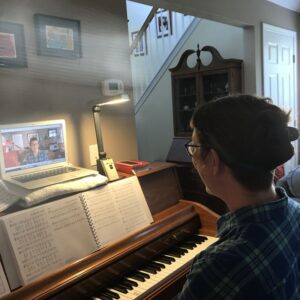By Sally Messner
What does a congregation sound like when we’re all singing at our individual devices? Until we can gather together and sing safely in person, church musicians will continue to explore creative ways of fostering community with their ensembles and congregations.
Prerecord Music for Worship
Hymn Sharing
Contribute to and borrow from groups like the COVID Hymns YouTube channel. Church musicians record themselves playing a hymn (usually at the organ) and display the hymn text during the video for singing along. Most of these include a singer or two. Posting guidelines are on their Facebook page.
Virtual Choir
With GarageBand or one of the several PC alternatives, record yourself playing a hymn or piece of service music. Send the accompaniment track to your choir or instrumentalists. They listen with headphones while recording their part, then send their recording back to you. In GarageBand, you can add numerous parts to your original track and create an audio file for people to sing along with. It can sound like they’re standing in the congregation rather than singing at home alone!
Teach people about the songs they know
Make a video to share information on hymn text writers, tune writers, and stories about the context in which a hymn or musical piece was written. If you highlight a song that has words, you can include the lyrics in the description of the video (YouTube ) or post them separately (Facebook) so that people can sing along. If you don’t want to make a video yourself, you could find a recording on YouTube and send the link with information about the piece in an email.
Resources
Consider the copyright. If a tune or text is under copyright, be sure to include your church’s license number in the description before posting a performance to a platform like youtube or Facebook.
John Jahr, Director of Music at Good Shepherd Lutheran Church and Preschool in Raleigh, NC, makes informative videos a couple of times per week. Check out the Music Minute on Good Shepherd’s YouTube channel.
Where to find information about hymns:
Virtual Hymn Sings
Set a time to gather people for a pause in the day to sing. You can do this with many different platforms and working with each might help you find which works best for your context.

Facebook Live
The Community Video Hymn Sing page goes live on Facebook nearly every night at 7:00 pm Central time for very brief time of prayer and singing. This lasts just about 10 minutes and has an audience that consistently follows (and more of us who join when our kids’ bedtime schedules allow). The only break to this rhythm is their leading morning prayer on Tuesdays each week, rather than a nightly hymn sing. You could invite your congregation to tune in. You can also (or instead) lead your own event using Facebook Live.
Zoom
Zoom allows the community to see all who have gathered in a way that Facebook doesn’t. With Facebook you can comment in real time, and see people’s names (maybe the occasional profile pic), but the only live video feed is coming from the host. With Zoom, anyone with a video can be seen. And if you can’t access via a device with video, you can still call in to the gathering. Before you begin singing, be sure to mute everyone. Because there is a delay, if people are not muted and all begin singing, they will not be in time with you as you hear it, and they will not be in time with each other. So remember that the mute button is your friend! Consider asking participants to request hymns live and share stories about why those hymns are meaningful for them. People are craving connection in this time.
More music friendly digital platforms
- Google Hangouts
- GoToMeeting
- House Party
Study and pray together
Using any of the above platforms, you can create intentional times for your community to interact with you and with each other.
Daily Prayer
In the front of Evangelical Lutheran Worship, you’ll find brief orders for daily prayer as well as the longer forms, with music, in the liturgy section. Taking these forms, you can read Scripture, sing, and pray for as short or as long a time as you’d like.
Bible Study
Explore the many songs in the Bible. In addition to the Psalms, there are all the canticles—the songs of Moses, Miriam, Hannah, Mary, Zechariah, Simeon, and many others. A quick internet search will help you find the canticles with their biblical references. Studying their scriptural origins and talking about them as an ensemble can deepen the meaning for performers and listeners alike.
About the Author
Sally Messner is the Director of Worship and Music at Holy Cross Lutheran Church in Livonia, Michigan, and the Schola Director for the Institute of Liturgical Studies at Valparaiso University. She is a 2005 graduate of Luther Seminary’s Master of Sacred Music program.
Photo by freestocks.org



